
The bell moved with us from Connecticut to New Jersey
and I enjoy its distinct chiming when the wind blows.
.
Sunday, 14 April 2019
A Visit to Arcosanti in Arizona
My garden's name is BelleWood. C'est tres belle, and there are bells in the garden. The first of which I bought in 1991 when we first visited Arizona and Arcosanti.

The bell moved with us from Connecticut to New Jersey
and I enjoy its distinct chiming when the wind blows.
So of course, when we were setting up where to go and what to do on an April family vacation in Sedona, Arizona I put in a bid for Arcosanti. (And another bell.) Paul knew what it was. The other four did not. There was, for example, a request for a vortex visit. Sedona, apparently, is very much into mystical, magical, crystallography, auras, and vortexes. Some discussion about a prior disappointing visit to the Earthship Biotecture in Taos, New Mexico where they had no tour, sort of wander outside, on your own. I prevailed. We would visit Arcosanti.
A visit to Arcosanti is incomplete unless you know something about Paolo Soleri. Born in Italy early in the 20th century, Soleri received an advanced architectural degree with honors from the Politecnico di Torino in 1946. He visited the United States in December of that year, subsequently spending a year and a half in an architectural apprenticeship with Frank Lloyd Wright at Taliesin West in Arizona, and at Taliesin in Spring Green, Wisconsin. A decade later, in 1956, Soleri, his wife Colly, and their first child settled in Scottsdale, Arizona. He developed the concept of Arcology, architecture coherent with ecology, envisioning it as a hyper-dense city designed to reduce the reliance on the automobile and looping roadways. Instead there would be ready access to shared, cost-effective infrastructural services. Minimizing the use of energy, raw materials and land would reduce waste and environmental pollution, conserve water and reduce sewage, increase human interaction and also interaction with the surrounding natural environment. He began building Arcosanti in 1970 with the help of architecture and design students as a place to test his urban design hypotheses.
A midmorning start. Once again, onto I-17 South, this time to exit 263, Arcosanti Road. Turn onto a mile and a half of unpaved road, watching out for the occasional young cow that bolts across to rejoin the rest of the herd.
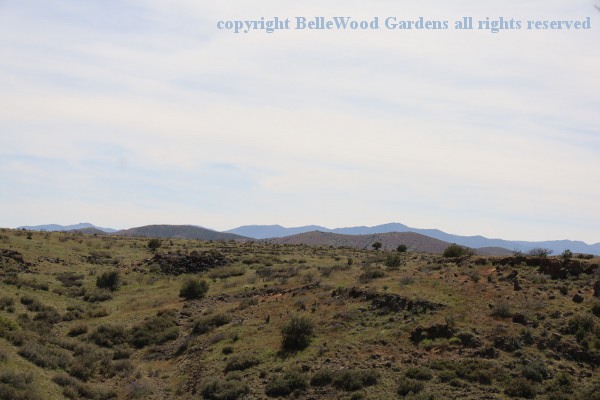
It's a harsh, sparse, dry landscape, as you might expect in a region
with a total annual precipitation of just a scanty 8.2 inches in a year.

There are a few other cars in the parking area. A walkway and steps down

to Craft III, the main building which integrates living and working conditions
within a single structure. There is housing on the first level, a visitor's center,
the dining area on the second level, and a gallery on the fourth level. It's noon

so we go to the cafe for the buffet lunch. Ample choices, simple, tasty food, and a reasonable $12 per person. Staff, students, and apprentices eat here too, 3 meals a day. The room is spacious, airy and light. There's an ornamental piece with multiple bells, chandelier-like. Any food scraps go into a compost bin, leftover liquids into another bucket.
Completed, Arcosanti is intended to house and partly sustain 5,000 people on 25 acres of land. Since 1970, when Arcosanti was begun, only a very modest portion of Soleri's Arcology has been built. Nothing has been added in the last 8 years. The current population - staff, students, volunteers, is less than 100. Compare this with Phoenix, the nearest city, which has a 2019 population of 1.6 million in a sprawling metropolitan area.

Concrete. Arcosanti is industrial chic, built with concrete.
Stairwells must have been poured in place using forms.

Textured concrete portions were silt cast, then lifted into place.

The gallery features both bronze cast and ceramic bells for sale. It is where
tours begin, with a long, well done video about Paolo Soleri and Arcosanti.
UPDATE: My two newest Arcosanti bells are now installed at BelleWood Gardens.

Somewhat less visible than we had hoped. Deliberately hung asymmetrically
on purpose. Now waiting for a good breeze so we can listen to them chime.
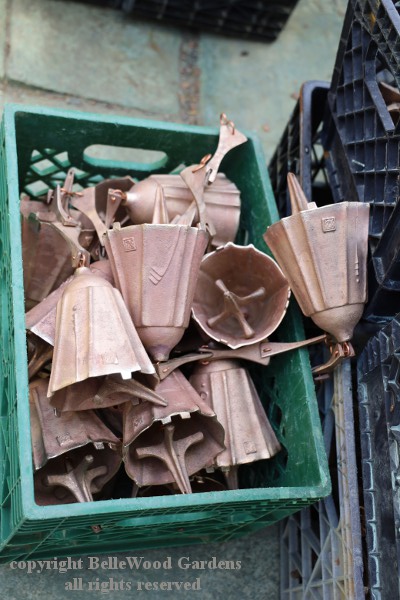
Bronze bells are cast in the Foundry Apse.
Molten metal poured into molds, cleaned,
dipped into an acid bath to begin patination.
Arcosanti's income comes from the sale of bells, tour fees from perhaps 30,000 to 40,000 tourists each year, and students from around the world who come to apprentice, attending workshops and classes in construction techniques, Soleri and the Arcology's concepts. Their tuition is another type of income. The workshops are 5- to 6-weeks in length, some people come and live in Arcosanti for a year or more.

The Ceramics Apse (birthplace of the silt cast bells) faces south, designed to admit
the maximum amount of sunlight in the winter and fill with shade in summer's heat.
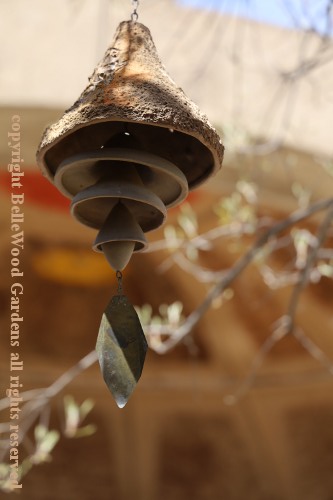
A silt cast ceramic bell. The surface has a rough texture,
characteristic of the sand mold. Plaster molds are smooth
and anything plaster cast picks up, reflects that surface.

The open-air amphitheater can seat 500 people for performances, conferences,
and other activities. A fabric roof can be drawn to cover and shade the theater.

Sentinel-like dark green Italian cypress, and dusty gray-green olive trees.

The few olive trees do produce. The fruit is harvested, then pressed for oil.

Our tour group passes one private apartment with a loquat tree.

Another has a border of bearded iris in the ubiquitous purple.

Arcosanti makes use of mostly desert and Mediterranean vegetation,
plants very tolerant of the arid climate, and require little maintenance.
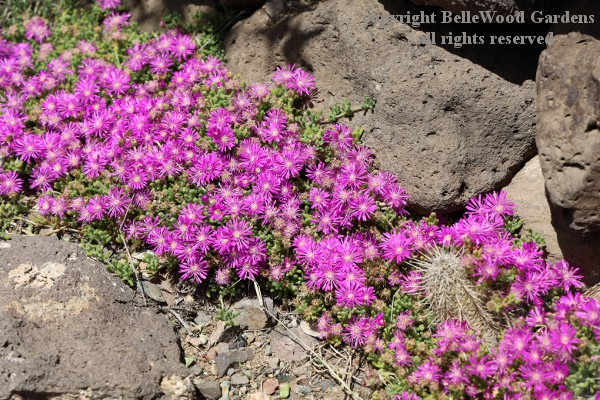
Vivid daisy-like fuchsia flowers of ice plant, Delosperma cooperi, from South Africa.
Our tour concluded, people disperse. Two of our group walk out into the landscape for an overview of Arcosanti's buildings at a distance. We four find a shaded terrace with table and chairs outside the dining area. I look up

and see some swallow nests overhead in a location sheltered from any wet weather.
Built from small pellets of mud from the water's edge, stacked like little drippy bricks
around the birds. The site plus low humidity keeps nests from crumbling as they dry.

Cement, fine and coarse aggregate, water. Concrete. Some has been poured in forms.
Others, silt cast slabs, then lifted into place when cured. Designs and color can be part
of the silt bed, providing color and texture to the finished piece. Exposed, it will wear
but where protected from weather, sun and rain - a ceiling, for example - it will remain.

A large public area with space for both events and meetings, the Vaults are the midpoint
of Arcosanti's site. Interestingly, sound is moderately amplified in the arch-shaded plaza.
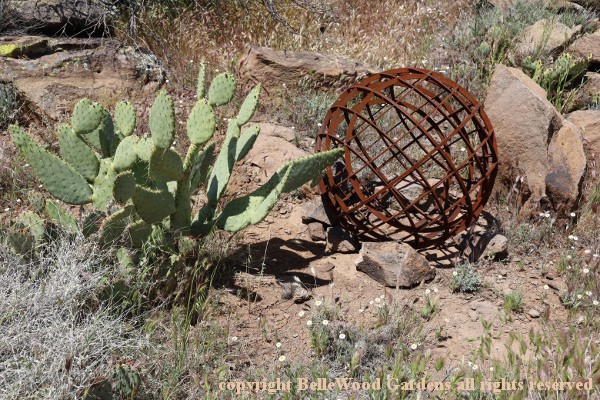
A sphere, rusted even in the dry desert air, sits on the bare mineralized ground.
Nearby, a prickly pear cactus looks quite green by comparison to withered grass.
It will be interesting to learn what the future years might bring for Arcosanti.
Back to Top